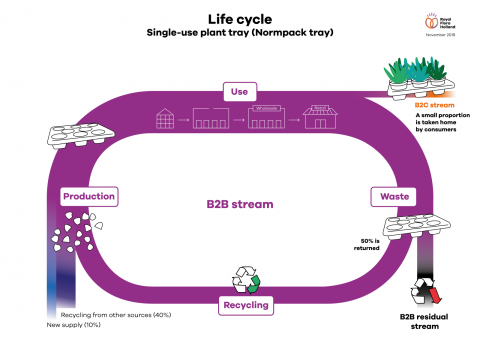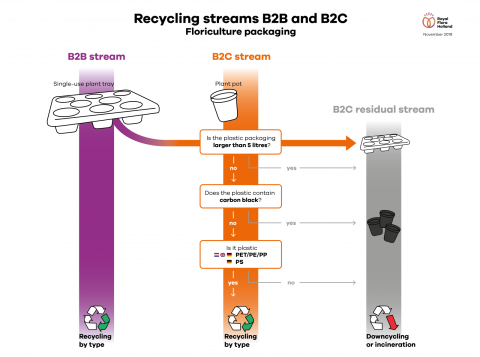
The life-cycle of a single-use plant tray
What is the life-cycle of a single-use Normpack plant tray? from which raw materials is hte tray made? How far have we progressed in the recycling of these materials?
Each Normpack tray is made of the same plastic: Polystyrene (PS). Normpack trays are 100% recyclable. Producers reuse all this material, after processing, for the production of new Normpack trays. This is done on a large scale.
Normpack tray production
A Normpack tray generally consists of 90% recycled materials:
- 50% recycled, used plant trays
- 40% recycled material from other flows (e.g. inside of refrigerators, clothes hangers)
Producers also use approximately 10% of new material. This is done, because there is not enough recycled material of sufficiently high quality available. Recycling is therefore very important for the production of Normpack!
Only recycled material in light colours as a raw material for lighter coloured trays can be used, such as the insides of refrigerators. All kinds of colourful recycled material, that cannot be re-used otherwise, can be used as raw material for black (or dark-coloured) trays. Black (or dark) trays thus ensure the highest possible percentage of recycled material and also the highest circularity.
Recycling is cheaper!
From a social responsibility perspective, it is important to use as much recycled material as possible in the production of new trays. But there is another good reason for doing so: recycled material is cheaper than new plastic! If a sufficient amount of recycled material is available, a manufacturer will choose to use it.
Recycling Normpack trays
Royal FloraHolland research shows that in the Netherlands and in Germany no less than 50% of the used trays are recycled into new trays.
A Normpack tray is a 'business-to-business' packaging (B2B), intended for transport from grower to shop. Recycling in the B2B flow is generally a success.
Trays that consumers take home from a garden centre are not being recycled. Why not? The trays are too large. In the recycling of 'hard' plastic submitted by consumers, anything with a volume greater than 5 litres is rejected from the recycling process. Indeed, the sorting machines consider larger pieces as commercially used plastic (B2B) and not consumer plastic. Although commercially used plastic is often highly recyclable, recyclers do not receive payment for it, and therefore it not sorted.
Recycling plant pots, sleeves and plugs
Plants usually need a pot - especially house plants. The same pot is generally used throughout the entire life cycle - from small plant at the grower, to beautiful plant in the home. These pots are easy to recycle into new pots (or other products) and this is done on a large scale, as long as the pot is not black in colour.
We cannot sort black pots out of consumer waste. These usually contain 'carbon black' dye. Recycling companies use current techniques (infrared) that do not recognize this type of plastic. Therefore, these pots end up in the residual flow of unsorted plastic. Growers increasingly make use of pots in other colours. It is expected that the number of black pots will decrease rapidly, so that more pots can be recycled.

Recycling streams
